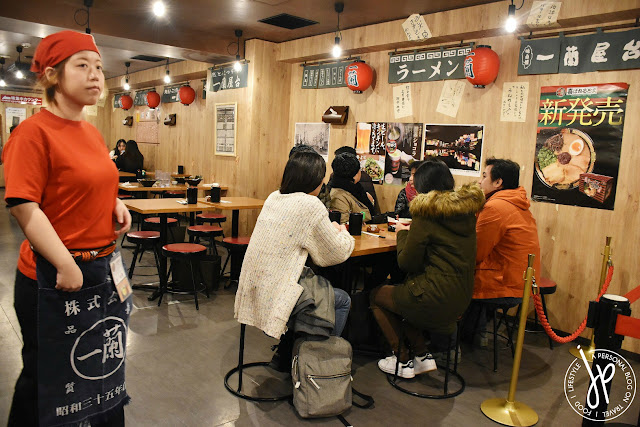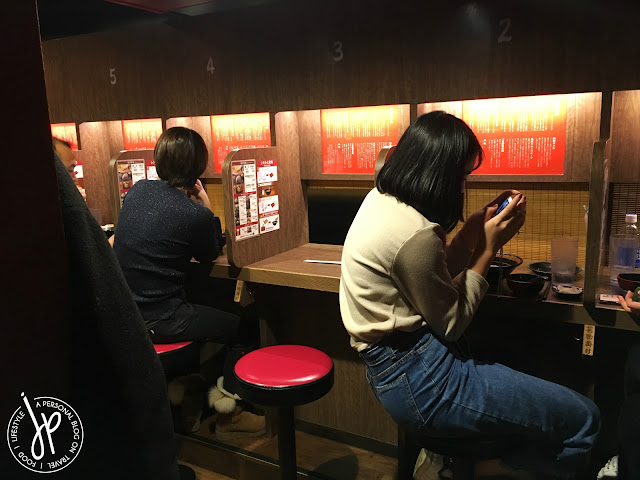Ichiran Ramen Review
Wednesday, March 21, 2018Ichiran is a popular Japanese ramen shop which originated from Fukuoka in 1960. What started as a small stall flourished into a ramen chain with 65 locations in Japan and branches found in Taipei, Hong Kong, as well as in Brooklyn, New York. In Dotonbori, the Ichiran branch is open for 24 hours.

Ichiran serves tonkotsu ramen, a pork bone based soup broth. Tonkotsu ramen is made by boiling pork bone and other ingredients for several hours to get its rich taste. It was initially prepared as an affordable food served to fish market workers in Fukuoka. In Japan, Ichiran and Ippudo (yes, the one in Manila) are the most popular ramen chains that serve this type of ramen.
Since it was my first time to visit Ichiran, I'll give you my honest, first impression on their well-loved ramen.
1. Order Process
We arrived at Ichiran Ramen Asakusa branch at around 10:30 AM so there wasn’t a build up of customers yet. The staff asked us if we preferred to be seated at the table area or at the booth (they call it counter, too). Since we are 7 in the group, we chose a table.

Ichiran has a queuing system which allows you to line up at the vending machine to get your order. They only have one type of ramen, which is tonkotsu, and you can just customize your order by getting extras such as rice, additional sliced pork, dried seaweed, etc. The basic ramen costs ¥890 and the add-ons start at ¥120. There’s also a set meal that costs ¥1,490.
To order, insert your bills or coins in the machine, select your desired ramen (whether the basic ramen or the set) and then press the button for your chosen add-ons (optional). Get your meal tickets and your change (if any).




Once we’re seated, the waitress assigned to our table handed us a sheet of paper to further customize our ramen. I chose a medium Dashi (pork stock), medium richness, no garlic, with green onion, with Chashu (sliced pork), with ½ spicy red sauce (mild), and firm noodle texture. I also added an extra set of chashu and kikurage mushrooms. If you’ve been to Ramen Nagi before, this will not look strange to you.

After encircling our ramen preferences, the waitress gathered the sheets and meal tickets. It only took less than 10 minutes for our orders to arrive. While we waited for our orders, the queue began to form, which I think extended outside the restaurant’s automatic sliding doors. That’s how popular this ramen chain is to both Japanese and foreign tourists.

2. Taste
If you’ve eaten ramen at Ippudo and Ramen Nagi, Ichiran’s tonkotsu ramen is very similar. That’s because all three restaurants cater to this pork bone soup dish. Ichiran’s ramen is also tasty, has ample amount of pork for its basic ramen, and the amount of noodles in each bowl was already filling. If you are a light to moderate eater like me, the basic ramen bowl is already enough. I barely touched the extra chashu (pork slices) and wasn’t able to finish my bowl.


I didn’t order drinks because I find the selection limited and pricey, so I opted for their free water (self-service).
If I had the chance to change the specifics of my order, I would’ve chosen a strong and rich taste of dashi. If I remember it correctly, I didn’t find any condiments on the table like pepper, chili oil, or sesame seeds. Not that the dish was bland or lacking anything - I just have this habit of adding a bit of extra for my own preference.
3. Ambiance and Facilities
Though the restaurant gets full easily, the place remains pretty subdued. You can hear a bit of chitchat here and there on the table area, but if you like to enjoy your ramen on your own, the Asakusa branch has a booth at the inner portion of the restaurant. The booth is designed so that you can enjoy eating this highly-valued tonkotsu ramen and savor its fulfilling, rich taste, without having to feel conscious about people watching you as you slurp the last bit of pork broth and noodles.

Near the booth area is their women’s toilet. Considering the amount of people in Ichiran Asakusa branch before and during lunch time, the toilet was well-maintained and well-stock with bathroom tissue. They maximized the use of the space in the sink which combined all faucet, hand wash, and hand dryer.


Located at the entrance, Ichiran displays souvenir ramen packs which you can take home. There’s also a pack of Ichiran noodles being sold at Don Quijote at a much lower price.
Though the restaurant gets full easily, the place remains pretty subdued. You can hear a bit of chitchat here and there on the table area, but if you like to enjoy your ramen on your own, the Asakusa branch has a booth at the inner portion of the restaurant. The booth is designed so that you can enjoy eating this highly-valued tonkotsu ramen and savor its fulfilling, rich taste, without having to feel conscious about people watching you as you slurp the last bit of pork broth and noodles.

Near the booth area is their women’s toilet. Considering the amount of people in Ichiran Asakusa branch before and during lunch time, the toilet was well-maintained and well-stock with bathroom tissue. They maximized the use of the space in the sink which combined all faucet, hand wash, and hand dryer.


Located at the entrance, Ichiran displays souvenir ramen packs which you can take home. There’s also a pack of Ichiran noodles being sold at Don Quijote at a much lower price.


Our dining experience was a pleasurable one, especially because we had a special tonkotsu ramen recipe and history, brewed over the years. I also liked the idea that they maintained the vending machine system, which in my opinion, is still more efficient than the standard menu booklet option. However, to be able to experience the unique Ichiran Ramen experience, I suggest dining at the booth. There are many branches around Tokyo and they’re mostly located in popular hubs so you’ll definitely find one that’s near you.
Overall Rating: 3.5/5
Disclaimer: This is not a sponsored post. The contents of this entry are purely my opinion and 100% honest based on my dining experience.





0 comments